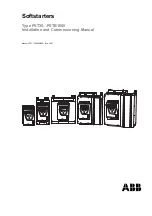
51-52-03-07
Page 3
Output Types
The following output types are
available per the model selection
guide:
•
Current output
•
Electromechanical relays
•
Solid state relays
•
Open collector output
•
Solid state relay (10 amp)
externally mounted (optional)
•
Auxiliary current output
(optional)
Output Algorithms
The UDC3000 is available with one
or more of the following output
algorithms:
Time Proportional - provides On-
Off or Time Proportional (Relay)
output.
Current Proportional - supplies
proportional direct current output for
final control elements which require
a 4-20 mA signal.
Position Proportional - positions a
reversible motor with a feedback
slidewire in proportion to the output
of the control algorithm. Requires 2
output relays.
Time Proportional Duplex -
depending on which control
algorithm you select, this duplex
output algorithm can provide On-
Off Duplex, Time Proportional
Duplex, or 3 Position Step Control.
The time proportional duplex output
provides independent PID tuning
constants and two time proportional
outputs; one for heat zone above
the 50% output, and one for cool
zone below 50% output.
Current Proportional Duplex -
similar to current proportional but
provides a second set of tuning
parameters and a split range
current output or a second current
output via the Auxiliary output
option, for the heat and cool zones.
Output Algorithms,
cont
Current/Relay Duplex (Relay =
Heat) - a variation of Duplex with
Current active for 0 to 50% output
(Tuning Set 2) and Relay active 50
to 100% output (Tuning Set 1).
Current/Relay Duplex (Relay =
Cool) - a variation of Duplex with
Current active for 50 to 100%
output and Relay is active for 0 to
50% output.
“Universal” Output Model -
Flexibility of the Output Algorithms
allows the Current Output Model
with 2 Alarms (DC300K-E) to be
also configured for time simplex,
time duplex, or three position step
control plus, of course, the original
capability of current simplex and
current/time duplex control. A Relay
Output Model with Auxiliary Output
can also be configured for these
output algorithms.
Control Algorithms
Depending on the output algorithms
specified, the controller can be
configured for the following control
algorithms:
•
On-Off
•
PID-A
•
PID-B
•
PD with Manual Reset
•
Three Position Step Control
The Three Position Step
Control algorithm allows the
control of a valve (or other actu-
ator), with an electric motor
driven by two controller output
relays; one to move the motor
upscale, the other downscale
without a feedback slidewire
linked to the motor shaft.
Accutune does not apply to this
algorithm. Features of this
algorithm are:
1.
The controller can use all
three modes of control
(PID) instead of PI only.
2.
Three Position Step is an
automatic backup mode to
Position Proportional
Control if the feedback
slidewire signal should fail.
Configuration
You decide how the controller is to
interact with the process by select-
ing, through
simple keystrokes, the
functions you want.
Multi-language prompts guide the
operator step-by-step through
the
configuration process assuring
quick and accurate entry of all
configurable parameters. There are
no internal jumpers, all configu-
ration is via the keyboard. Five
languages are available via
configuration; English, French,
German, Spanish and Italian.
Control Modes
Manual or Automatic control with
bumpless, balanceless transfer
between modes is a standard
feature. In the manual mode, the
operator directly controls the
controller output level. In the
automatic mode, the controller will
operate from a local setpoint, or a
remote setpoint provided at the
second input or via
communications.
Alarms
Alarm output terminals are located
at the rear terminal panel. One or
two electromechanical alarm relays
are available to activate external
equipment when preset alarm set
points are reached. Each of the two
alarms can be set to monitor two
independent set points. Each alarm
setpoint can be either high or low
alarm. The alarm type can be
selected to be either of the inputs,
the Process Variable, Deviation,
Output, Shed from communications
or to alarm on manual mode. It can
also be used as an On or Off event
at the beginning or end of a
Ramp/Soak segment. The alarm
hysteresis is configurable from 0 to
100% of range.






























